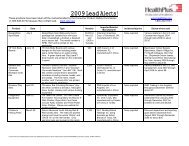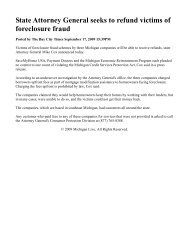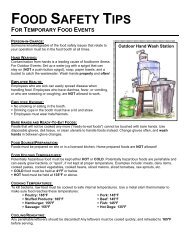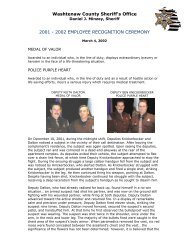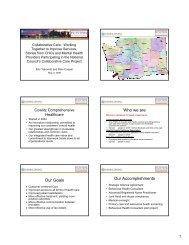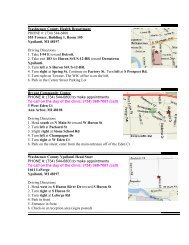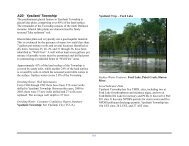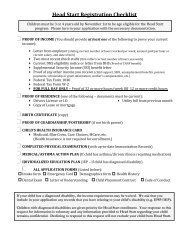Coliform Bacteria Fact Sheet - Washtenaw County
Coliform Bacteria Fact Sheet - Washtenaw County
Coliform Bacteria Fact Sheet - Washtenaw County
You also want an ePaper? Increase the reach of your titles
YUMPU automatically turns print PDFs into web optimized ePapers that Google loves.
<strong>Coliform</strong> <strong>Bacteria</strong> and Drinking Water<br />
Page 2<br />
What do the results mean?<br />
If coliform bacteria are present in your drinking water, your risk of contracting a water-borne illness is<br />
increased. A positive total coliform sample should be considered an indication of pollution in your well.<br />
Positive fecal coliform results, especially positive E. Coli results, should be considered indication of fecal<br />
pollution in your well.<br />
What should I do if coliform bacteria are detected in my well?<br />
Be concerned but do not panic if coliform bacteria are detected. Resample immediately if you have a positive<br />
sample before you treat, repair or replace the well. If you receive a second positive sample for total coliforms,<br />
or if the initial sample is positive for fecal coliforms, do not drink the water. Bring the water to a rolling boil for<br />
three minutes to kill the bacteria. You may also want to use bottled water as a temporary water source.<br />
How can I eliminate coliform bacteria from my well water?<br />
If coliform bacteria are present, the source of the problem should be identified. Resampling from several<br />
locations within the water system may be helpful. The entire water system may need to be thoroughly flushed<br />
and disinfected before a negative bacteria sample can be obtained. A well drilling contractor or a <strong>Washtenaw</strong><br />
<strong>County</strong> Sanitarian can help identify structural defects in the system. After the defects are corrected, the system<br />
should be disinfected and the water retested before drinking.<br />
How do I chlorinate/disinfect my well?<br />
1) Draw off 4 gallons of water into a 5-gallon bucket. Mix 1 gallon liquid bleach with the water. (Liquid bleach<br />
should not be used with a steel well casing; use granular chlorine instead.)<br />
2) Turn off the power to the well pump. Remove the well cap; be careful if screws or bolts are rusty. (If the<br />
well cap has one large bolt in the center, do not remove it. Have a licensed well contractor disinfect your<br />
well. If your wellhead is buried or if you have a shallow well, contact a Sanitarian at (734) 222-3800.)<br />
3) Pour the bleach mixture into the well between the casing and the cross bar or “T” bar. DO NOT pour the<br />
mixture into the 1” center hole. Newer wells have markings or a statement next to the correct hole. Try not<br />
to get the solution on the wires inside the well.<br />
4) Connect a clean hose to an outside spigot and extend it into the well 4 feet.<br />
5) Turn the power on to the well pump. Turn on the spigot connected to the hose in the well and let water run<br />
in the well for 20 minutes. This distributes the disinfectant throughout the well system. Turn the spigot off.<br />
6) Turn off the power supply to the well pump. Once the power is off, remove the hose from the well and put<br />
the well cap back on the well using the existing nuts and bolts.<br />
7) Turn on the power to the well pump. All work is now completed on the wellhead.<br />
8) Now it’s time to distribute the bleach to the pipes inside the home. Turn on each indoor and outdoor water<br />
faucet, run the shower, clothes washer, dishwasher, and any outside hydrants or plumbing fixtures in other<br />
buildings, and flush each toilet a couple of times. Allow cold water to run until you can smell bleach, then<br />
turn off all the faucets. (Note: Some water softening units should not be chlorinated; contact your water<br />
softening company before disinfection to see if you should bypass the softening system.)<br />
9) Allow the solution to stay in the system for a minimum of eight hours, or overnight. During this time you<br />
should not drink, bathe, wash clothes or cook with the water, but you can use it for toilet flushing.<br />
10) After the solution has been in the system for a minimum of eight hours, connect a hose to an outside spigot<br />
and allow water to run onto the ground for 20-30 minutes to flush the bleach from the system. Try to keep<br />
the water away from your drainfield and any plants or trees if possible. Turn off the spigot and then run<br />
each indoor and outdoor water faucet for 2-3 minutes to remove the solution that was in the pipes.<br />
11) It is now time to collect the water sample. Follow the water sampling instructions that came with the bottle.<br />
Where can I get more information?<br />
<strong>Washtenaw</strong> <strong>County</strong> Department of Public Health - Environmental Health Division<br />
705 N. Zeeb Rd., P.O. Box 8645, Ann Arbor, MI 48107-8645<br />
(734) 222-3800<br />
www.e<strong>Washtenaw</strong>.org Rev. 7/13





